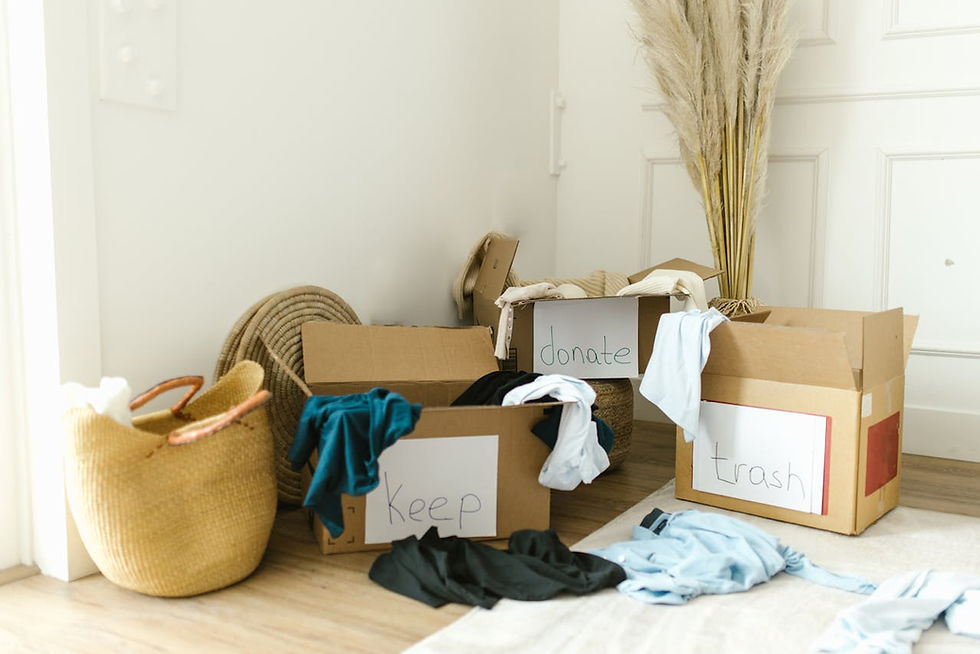How to transition your wardrobe for summer
- Imagine It Done
- May 27, 2020
- 4 min read
Updated: Oct 30, 2020

The transition between winter and summer is not only a time to swap out cold for warm clothes, it is an opportunity to edit and organize your closet. Consider this as a time for self-discovery. Inevitably, stuff accumulates from season to season, as we buy more items each year. Every spring, take time to figure out what you really want to keep and what systems work for you. If you use the transition in this way, it will be the gift that keeps on giving every year.
Carve out some time for this process. Make sure you set aside sufficient time to give each item full consideration. This is a chance to not only edit your items but make your closet work better for you on a daily basis. Before you start, purchase or collect the tools that are essential during this process.
In the closet transition from your winter wardrobe to summer, follow our eight-step process: edit, categorize, clean, store, stow delicate items, stash shoes, repel pests, and choose the right spot.
Here are a few tips that will help you as you go through this process.
1. Edit your clothing
Start with the clothing you are about to stow away. Go through each item and decide whether to keep, toss, donate or give away.
As you do, ask yourself this question: Who I am now? This isn’t about who you were or who you want to be. Be honest with yourself: Is this something that flatters, fits well, and that I wear regularly? If not, give it away or consign it.
2. Categorize each item
Group clothing by fabric and categories. Create piles of each of the following: silks, wool, fur, suede, leather, cotton, linen, and rayon.
Store categories into correct size bins and garment bags.
3. Clean your closet
In rearranging any space, it is important to clean as you go. Have a surface cleaner, such as Windex, and a clean cloth handy. With moving things out, it’s a great opportunity to clean all the surfaces in your closet and rid it of dust.
Sort through all garments. Make sure to empty pockets, launder or dry clean things that are dirty, and repair any torn clothing.
4. Store your winter clothing
Always pack the heaviest clothes on the bottom.
Hanging items should be placed into cloth garment bags, preferable for long term storage, because there is less risk of moisture being trapped in the bag. (By the way, if you need help in the moving process and storing process, let us know!) Remove all plastic and dry cleaning packing materials from garments as they too hold moisture.
An alternative to hanging garments is to lie them flat in a bin folded with acid-free tissue paper between each item.
5. Stow delicate items
Clothes made from natural fibers need air circulation. Do not store them in airtight containers as moisture may build up and create mildew. To be extra cautious, place a dehumidifier in the room where you decide to store your clothing.
Be careful to keep cedar off the fabric because it will stain.
Also be mindful not to cram too much clothing into one container. Leave room for air to circulate.
6. Stash shoes and accessories
Make sure to clean boots and shoes before you store them. Designate a bin for shoes only and label it with the contents and season.
7. Repel pests
Wool and delicate fabrics can attract moths or other insects, which leave holes in your garments. Be certain to add the cedar or moth repellent into the canvas or muslin bins as protection.
8. Choose the right spot
The big question that looms during this process is always how and where to store your winter clothing. Depending on your home, you may choose under the bed storage options, uppermost shelving in your closet, garment racks in a guest room, a guest room closet, or a storage unit.
We recommend canvas boxes or muslin bags and cloth garment bags. Hang clothes on wooden hangers or padded hangers to best protect them from stretching or warping.
Store clothes in a cool dry place. Fabric is affected by humidity and extreme temperatures. For this reason, attics and garages are not ideal.
As always, make sure to label the containers or garment bags so you don’t need to open them to know what is inside.

Now you will have space available to introduce your summer clothes back into your closet. It can feel like Christmas all over again as you take out clothes you haven’t seen in months. Don’t forget to edit those clothes before you add them to your wardrobe.
To curate the summer transition, add storage bins and baskets for accessories to match with what you already have in your closet. Place sandals and lightweight shoes under hanging clothing, bathing suits and cover-ups in a bin on a shelf. Jewelry and belts fit well in an acrylic drawer on a shelf.
If you’re lucky and there is shelf space to spare, place hats next to the acrylic drawer with the accessories. Otherwise, several hooks on an empty wall will work perfectly.
The changing seasons will be a refreshing, exciting, and life-changing project. Enjoy the process of discovery and a brand new you!
Looking for closet products to help you organize your closet? Check out the closet section of our shop.



